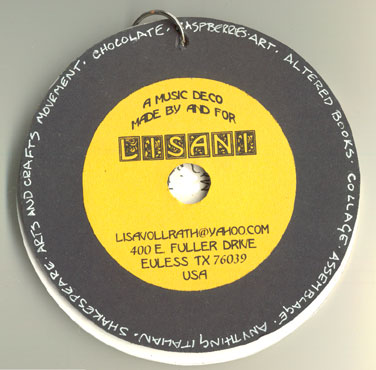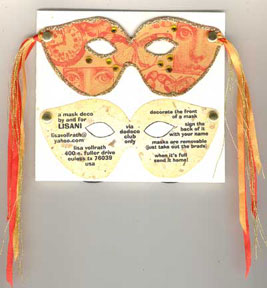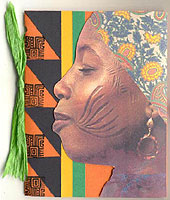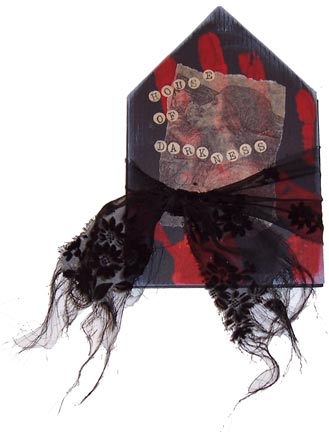When I first heard the word decos, I set out to find out all about them, and discovered that while there are plenty of sites showcasing decos, there really aren’t any that talk about what they are, how to make them, and what the rules are in the deco culture. In early 2003, in response to the overwhelming number of emails I was recieving from visitors to this site about decos, I decided to write down what I know about them. I started a private deco group for experienced artists who wanted to learn about decos, and from their questions, I assembled the following, fondly known as Decos 101.
What is a deco?
A deco is a variation of a friendship book. Friendship books, at their most basic, are small booklets that are mailed from penpal to penpal. Usually you see little 3×5 pieces of paper stapled together at the corner, with the front sheet decorated with stickers, and a bunch of writing that will tell you who made the book, who it’s for, what the maker is into, if they’re looking for new penpals, etc. A lot of this is done in code (NPW=new pals wanted). The emphasis is on learning about people and finding new penpals, and not necessarily on making something beautiful.
Decos, on the other hand, are all about making something beautiful—the booklet is the emphasis, and finding new friends comes from finding booklets that are made in a style that appeals to you. Some of the decos I’ve seen are almost mini altered books, using many of the same techniques and materials, along with bookbinding, collage, calligraphy, etc.
Decos travel the world, going from one decorator to another. Each decorator or signer adds their work to a single blank page of the deco, and then passes it along to the next person. In traditional deco swapping, there is no set list of people to whom a deco will be passed, so you never know who will work in your book, or when it will be completed and arrive back home.
How do I make a deco?
Since each artist’s style is unique, there is no single answer to this question. However, decos do share some common elements:
- It should provide information about the maker and the person for whom the deco is made—these might be two different people, since decos can be made by one artist for another. Usually, that means providing names, email addresses and mailing addresses.
- It should have places for each artist to decorate. Whether that means pages, sections, pieces or something else altogether is up to you.
- It should have an indication of theme, and at least one page decorated by the maker. Remember that often, books travel to other countries. Using words may not be sufficient to convey your theme. Your art will break through those language barriers every time!
Other than that, there aren’t really any rules. Take whatever bookmaking or cardmaking skills you have, and go to work! Most decos have from 4 to 8 pages for people to sign and decorate. Each person works on a single page, unless the deco’s owner gives them specific instructions to do otherwise. Pages are attached by a variety of means: I sew, punch holes and run ribbon through them, use brads or rings. Under no circumstances should you use staples! They are the scourge of fine decomaking, and tend to tear up both your books and those that are mailed with yours. Avoid them.
(I’ve taken a little abuse from some nervous people about the staples remark. Quite a few folks say they’ve never received anything BUT stapled decos. Let me just say that if that’s true, it’s unfortunate. I think I can count on one hand the number of staples I’ve seen in the deco groups I belong to, and they were done properly—with the staple shot into the spine, and closed on the inside of the book, where it will not tear up anything. This stapled at the corner thing is for friendship books, not fine decos. My advice is to give the stapler to your little sister for her friendship books, and learn a few simple binding techniques instead.)
If you’re looking for actual how-to instructions for making decos, check the How-To section of this site. There should be instructions for all sorts of little handmade books under Decos and Small Books.
What kind of paper should I use to make my deco?
First, let me say that decos don’t necessarily have to be made from paper. I’ve seen them made from fabric, tags, CDs—the only limit on materials is your imagination, and the cost of postage.
OK, having said that, assuming paper is your media of choice, then the type of paper is equally your choice. I’ve seen old magazine pages used, but I think they might be too flimsy for some folks to work on. I’ve seen recycled copy papers, regular bond or printer paper, watercolor paper, whatever. My choice is generally cardstock or colored printer paper, depending on the style of booklet I’m making. Some of my stuff is all folded, and a heavier paper holds up better. Remember, no matter what you use, it will act as the background for other artist’s artwork, so if you wouldn’t want to work on it, neither will they. Give them something you think will hold up.
How big should my deco be?
Again, there’s really no correct answer to this one. Most of the decos I receive are fairly small—no larger than a quarter sheet of letter sized paper. Sometimes they’re a little larger, and sometimes for fun, they’re made smaller—much smaller, in some cases. Mostly, the object is to keep the booklets in a size and shape that’s easy to mail, and to make them lightweight, so the postage cost stays low. Mailing many booklets per month can really get expensive, especially if you’re mailing overseas.
As for the number of pages to include in your deco, that’s up to you. I am not the Princess of Patience, so for every booklet I make that has six or eight pages, I make one that has four, knowing that it will come home faster than the larger decos.
What kind of glue should I use?
Why is it that paper crafters have so much anxiety over glue? Types of glues seem to be discussed ad nauseum, and there’s no real agreement on what’s best—probably because the type of glue you’ll enjoy using is influenced by your style of working.
All I can tell you is which glues I use. I have the following glues in stock at all times: Weldbond, Tacky Glue, E6000, cheap glue sticks. I do have assorted other adhesives, but I really don’t use them that often.
Weldbond is a heavy-duty white glue available in hardware stores. It’s industrial strength, and dries clear. I use it to glue porous embellishments that are too heavy for a glue stick. I’ve also used it to glue metal to paper with some success. Pretty much anything that’s glued on with this stuff isn’t going to come off once the glue has set.
Tacky Glue is a good all-purpose white glue that’s slightly thicker than normal glues. I use it mostly in altered books, to glue page blocks together.
E6000 is a solvent-based glue good for non-porous materials. If I have to glue down a piece of metal or glass, I’ll probably use this.
That leaves cheap glue sticks. I’m not kidding here—I don’t waste my time with brand name glues. I buy sticks in various sizes by the half dozen at either Wal-Mart or Office Depot. I use these for all paper work. If I’m gluing paper to paper, nine times out of ten, I use a glue stick. If I’m gluing paper to any other surface, I’m probably using a glue stick. I’m not shy with the glue, either—I’ll slather a nice, thick coat onto a background, layer collage elements on, and let it set for a few minutes. I rarely have a problem with things coming loose.
What information should I include in my deco?
I’ll use one of my own decos to illustrate the information I include. Just click on the images below to view an enlarged version.
 This is the cover of a music deco, made using a CD as the cover. Here, I’ve indicated the theme, using both words and visuals. I’ve also provided four pages, which will allow seven other artists to work in the book. The back page has a message on it saying the book should be returned to me in exchange for good deco karma and treats. Some people also use this area for messages, and each person who receives the book will write a little note there.
This is the cover of a music deco, made using a CD as the cover. Here, I’ve indicated the theme, using both words and visuals. I’ve also provided four pages, which will allow seven other artists to work in the book. The back page has a message on it saying the book should be returned to me in exchange for good deco karma and treats. Some people also use this area for messages, and each person who receives the book will write a little note there.
 This is the reverse side of the CD cover. Since the book was made by me, and is also made for me, I’ve provided my name (my deco name is Lisani), my mailing address, and my email address. If I were making this book for someone else, I would also provide the same information for her. Around the outer edge, I’ve given some information about my interests. Very often, these are provided as lists of seemingly unrelated terms. My list often looks like this:
This is the reverse side of the CD cover. Since the book was made by me, and is also made for me, I’ve provided my name (my deco name is Lisani), my mailing address, and my email address. If I were making this book for someone else, I would also provide the same information for her. Around the outer edge, I’ve given some information about my interests. Very often, these are provided as lists of seemingly unrelated terms. My list often looks like this:
art, altered books, collage, assemblage, digital artwork, anything Italian, William Morris, arts and crafts movement, Shakespeare, chocolate, raspberries, rat terriers
Those are all things in which I’m interested or things I like, so that’s what I list. Sometimes the list will vary, depending on the style of the book. Sometimes, I omit the list altogether, especially if the deco is going to one of my private swap groups, where everyone has already seen my interest list dozens of times.
How much of my deco should I decorate before I send it on to the next person?
When you make a deco, it’s customary to decorate at least the front cover. Some folks (like me) also do a little decorating on the inside front cover, along with some information about what the booklet is about, and where it came from. Some folks also decorate the back cover—mine usually get a label promising good deco karma and treats if the book is returned to me safely. You should not decorate any other pages in your deco. Leave that for the other artists.
What do I do with my deco once I’ve made it?
Short answer: send it to someone else! Decos are made to be passed around, so get yours into circulation. The easiest way to do that is to find a group of deco swappers, and join in a swap.
Where do I find other deco swappers?
Currently, there are over 500 different friendship book groups listed at Yahoo, and over 250 of them come up if you specifically search for the word deco—and those are just the ones that allow themselves to be listed. There are hundreds more that are completely private. Most of the deco groups are small, and a lot of the better ones require you to submit samples of your work before you’re admitted. Just hunt around, and you’ll find a group that suits where you are on your deco journey.
How are decos swapped?
There are three basic ways decos are swapped:
Random swapping – You make a deco, and send it to another deco artist. She decorates it, and sends it to a deco artist she knows. The deco is passed from artist to artist, with no set order or time limit. Once your deco leaves the person to whom you send it, you know nothing about its progress or path, until it eventually (hopefully) comes home to you. This is how most newbies swap decos. On the plus side, it gets your work out there. On the minus side, you probably won’t see all of your decos again. They get lost, thrown out, or kept, and because there’s no accountability, there’s really not a lot you can do to get them back.
Group swapping – You join a deco group, make a deco, and send it to another artist in the group. When she decorates it, it’s sent to another group member. Depending on the group, your deco may wander into other deco groups, or it may be confined to the group where it originated. On the plus side, you can generally post to the group asking the status of a specific deco, and someone will usually let you know where it is. On the minus side, your decos are always worked by the same limited group of people. Deco groups also have varying levels of loyalty. Some groups retain their members for years on end, while others seem to rotate people in and out regularly. Each time a member leaves the group, some of your decos may leave as well.
Round robins – You sign up for a round robin, make a deco with a specific number of pages, and pass your deco to an assigned person. She decorates it, and passes it to the next assigned person. In this type of project, you always know exactly who is working in your deco, and where it is. This sort of takes some of the adventure out of deco swapping, but for those who simply must have every single deco back in a timely manner, it’s a good way to go.
What do all those codes and letters mean?
Since decos tend to be small, some of the information included in them is written in shorthand. Here’s a quick list of the most commonly used codes:
ICR =I Can Return. That means the person is willing to mail the booklet back to the owner. Generally, it means that person is a private swapper with the book’s owner, or mails to her regularly.
NPW = New Pals Wanted. This person is looking for new penpals.
NSW = New Swappers Wanted. This person is looking for others who would like to swap decos.
NNP or SNNP = No New Pals, or Sorry, No New Pals. This person doesn’t want to take on any new penpals at the moment.
NNS or SNNS = No New Swappers, or Sorry, No New Swappers. This person isn’t looking for any new swap partners at this time.
What do I do when I recieve a deco in the mail?
Short answer: decorate it!
How do I decorate a page in someone else’s deco?
First, figure out what the theme of the book is. Sometimes that’s fairly simple: it will be printed on the cover. (If it’s not in English, use an online translator to figure out what it says.) Sometimes, you will learn more about the theme of the book from the work of the artists who have worked in the book before you. For example, the cover may say Butterflies, but the book itself may be done all in blue. Keep going with whatever themes the book has picked up along the way.
What information should I include in a page I decorate?
At the very least, your name or deco name. I always sign my pages with Lisani, and try to make my name a part of the composition of the page. If the book belongs to someone I know, I leave it at that—she probably already knows my email address and how to contact me. If the book owner or the person for whom the book was made are unfamiliar to me, I’ll try to include my email address, and occasionally I’ll also work in my city and state. Some people also add codes (see the list above) or their list of interests, but I like to keep my pages uncluttered.
What if I really can’t come up with a good idea for a page?
Occasionally, you’ll receive a book that just doesn’t appeal to you. Either the theme doesn’t inspire you (I get this way with Hello Kitty decos—bleh), or the book is poorly made, or you just don’t feel like you can contribute anything. Pass it on to the next person, and don’t worry about it.
How much of someone else’s deco should I decorate?
Unless there are other instructions included in the deco you receive, you decorate one single page in each booklet. When you’re finished, you send it along to another artist.
A Quick List of Deco Do’s and Dont’s
- DO think about deco construction. Make your books sturdy enough to endure being mailed repeatedly, and handled by artists whose style of working may be rougher than yours. DO provide pages that are strong enough to stand up to a little abuse. DO reinforce your binding area, especially if you’re punching holes.
- DO provide clear, readable contact information if you expect to receive your deco back. Remember to include your country in the address, since your deco may end up somewhere on the other side of the planet.
- DO leave some sort of identifying mark when decorating in someone else’s deco. Some folks sign their names, some leave their name and email address, and some give all sorts of info. Some work their deco name into the design of their pages. Whatever your style, be sure that your work can somehow be identified.
- If you join a swap group, DO read all the documents sent to you by the group moderator, and any information posted on the group’s site. If you have questions after you’ve read all this information, ask them.
- DO email your swap partner when you send her something, and when you receive something. Very often, swaps are sent over long distances or to other countries, and there’s a little anxiety involved while waiting for it to arrive.
- DON’T worry if you can’t come up with a really great idea for a page. If you get completely stuck occasionally, it’s OK to pass a deco along without decorating in it. If certain themes always give you trouble, try to arrange not to receive that type of deco.
Where can I find answers to questions about decos not listed here?
Whatever you do, DO NOT EMAIL ME ABOUT DECOS! Even if you can find my email address on this site, I will not answer your questions if they come to my personal address. If you have a question that pertains to decos, join a group that discusses mail art, and ask it there, or try posting the question on the message board.




